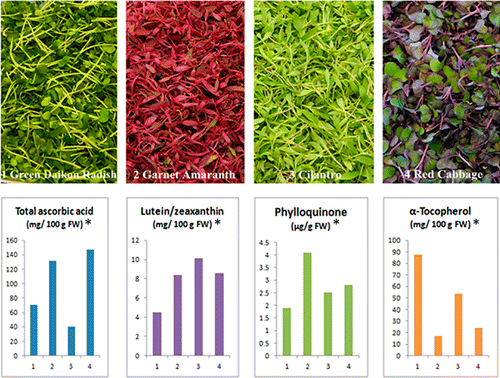Many trendy 'microgreens' are more nutritious than their mature counterparts

The first scientific analysis of nutrient levels in edible microgreens has found that many of those trendy seedlings of green vegetables and herbs have more vitamins and healthful nutrients than their fully grown counterparts. A report on the research appears in ACS' Journal of Agricultural and Food Chemistry.
Qin Wang, Gene E. Lester and colleagues point out that microgreens have gained popularity as a new culinary trend over the past few years, especially in upscale markets and restaurants. Those seedlings of spinach, lettuce, red cabbage and other veggies are usually 1-3 inches in height and harvested within 14 days of germination. They enhance the color, texture and flavor of salads, soups, sandwiches and other foods. Despite their growing popularity, no scientific information existed on how nutrients in microgreens compare to those in mature plants. To fill that gap, they analyzed vitamins and other phytochemicals in 25 varieties of microgreens.
They found that microgreens generally have higher concentrations of healthful vitamins and carotenoids than their mature counterparts. But they also found wide variations in nutrient levels among the plants tested in the study. Red cabbage microgreens, for instance, had the highest concentration of vitamin C, for instance, while green daikon radish microgreens had the most vitamin E. Concentrations of vitamins and carotenoids in popcorn shoots and golden pea tendrils were low compared to other microgreens, but were still as high as some common mature vegetables.
One other notable finding: Exposing microgreens to light tended to change the nutritional content, which is an ongoing research effort led by Dr. Lester and Dr. Wang, and results will be published soon.
More information: "Assessment of Vitamin and Carotenoid Concentrations of Emerging Food Products: Edible Microgreens", J. Agric. Food Chem., 2012, 60 (31), pp 7644–7651, DOI: 10.1021/jf300459b
Abstract
Microgreens (seedlings of edible vegetables and herbs) have gained popularity as a new culinary trend over the past few years. Although small in size, microgreens can provide surprisingly intense flavors, vivid colors, and crisp textures and can be served as an edible garnish or a new salad ingredient. However, no scientific data are currently available on the nutritional content of microgreens. The present study was conducted to determine the concentrations of ascorbic acid, carotenoids, phylloquinone, and tocopherols in 25 commercially available microgreens. Results showed that different microgreens provided extremely varying amounts of vitamins and carotenoids. Total ascorbic acid contents ranged from 20.4 to147.0 mg per 100 g fresh weight (FW), while β-carotene, lutein/zeaxanthin, and violaxanthin concentrations ranged from 0.6 to 12.1, 1.3 to 10.1, and 0.9 to 7.7 mg/100 g FW, respectively. Phylloquinone level varied from 0.6 to 4.1 μg/g FW; meanwhile, α-tocopherol and γ-tocopherol ranged from 4.9 to 87.4 and 3.0 to 39.4 mg/100 g FW, respectively. Among the 25 microgreens assayed, red cabbage, cilantro, garnet amaranth, and green daikon radish had the highest concentrations of ascorbic acids, carotenoids, phylloquinone, and tocopherols, respectively. In comparison with nutritional concentrations in mature leaves (USDA National Nutrient Database), the microgreen cotyledon leaves possessed higher nutritional densities. The phytonutrient data may provide a scientific basis for evaluating nutritional values of microgreens and contribute to food composition database. These data also may be used as a reference for health agencies' recommendations and consumers' choices of fresh vegetables.
Journal information: Journal of Agricultural and Food Chemistry
Provided by American Chemical Society


















